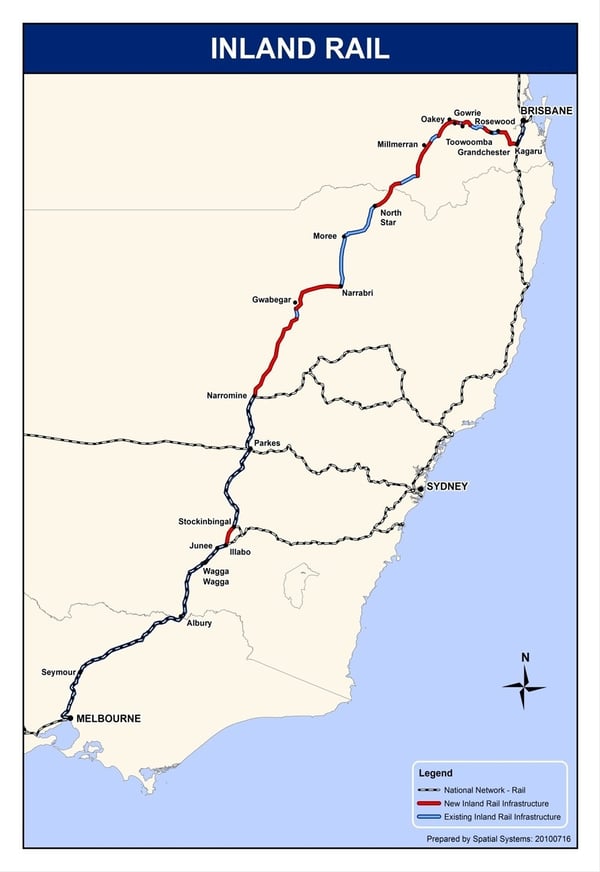*Last Updated: September 2025
The Inland Rail is reshaping Australia’s freight network — a $14 billion, 1,600 km rail line connecting Melbourne and Brisbane through regional Victoria, New South Wales, and Queensland. Designed for double-stacked freight trains up to 1.8 km long, the project will cut travel times to under 24 hours and boost regional trade links when southern sections open in 2027.
Get rail construction quotes online
A game-changer for freight and logistics
Stretching more than 1,600 kilometres, the Inland Rail is one of the biggest infrastructure undertakings in Australia’s history. When finished, it will connect Melbourne and Brisbane through the heart of regional Victoria, New South Wales, and Queensland, allowing trains to move freight between the two cities in under 24 hours.
The project is being delivered by Inland Rail Pty Ltd, a subsidiary of the Australian Rail Track Corporation (ARTC), with funding from the Australian Government.
Why it’s being built
Australia’s freight volumes continue to grow, and the existing coastal route through Sydney can’t keep pace.
The Inland Rail provides a faster, flatter, and more reliable inland path that:
-
Reduces travel time between Melbourne and Brisbane by nearly a third.
-
Takes tens of thousands of trucks off highways every year.
-
Cuts emissions and improves road safety.
-
Opens new markets for regional producers and exporters.
By linking the nation’s key agricultural and industrial regions, Inland Rail will future-proof domestic freight and export efficiency.
Current progress across the three states
Victoria
Major works are advancing between Beveridge and Albury, including new bridges, underpasses, and station upgrades.
The remaining construction through Benalla, Euroa, Broadford, and Wandong is scheduled for completion by 2027.
New South Wales
Freight services already operate on the Parkes – Narromine and Narrabri – North Star (Phase 1) sections.
Upgrades between Stockinbingal – Parkes are expected to finish in late 2025, while Illabo – Stockinbingal and Albury – Illabo are moving into full construction.
Northern design and land access planning are also progressing.
Queensland
Design and environmental approvals continue across four new sections from the NSW/QLD border to Kagaru near Brisbane.
These include dual-gauge tracks, extensive tunnelling through the Toowoomba Range and Little Liverpool Range, and connections to the existing coastal line.
Key stats at a glance
|
Total length |
~1,600 km |
|
Track type |
~1,000 km upgraded / ~600 km new |
|
Train capacity |
Up to 1.8 km long (≈ 110 B-double trucks) |
|
Primary freight |
~70 % domestic goods and produce |
|
Funding |
Australian Government – via ARTC |
|
Southern completion target |
2027 |
Towns and regions along the route
Victoria: Beveridge · Seymour · Benalla · Wangaratta · Glenrowan
New South Wales: Albury · Wagga Wagga · Junee · Parkes · Narromine · Narrabri · Moree · North Star
Queensland: Yelarbon · Inglewood · Toowoomba · Calvert · Bromelton · Kagaru
These towns are already benefiting from increased local contracts, supply-chain opportunities, and upgraded transport links.

Economic and industry impact
When fully operational, Inland Rail will:
- Deliver a multi-billion-dollar boost to regional economies.
- Support thousands of construction and maintenance jobs.
- Strengthen national export capability for agriculture and manufacturing.
For civil contractors, equipment suppliers, and plant-hire companies, it represents long-term work across bulk earthworks, bridges, tunnelling, track laying, and signalling.
Funding and delivery
The project is funded by the Australian Government and delivered by Inland Rail Pty Ltd (ARTC).
Each completed section will be integrated into ARTC’s open-access freight network, ensuring long-term national connectivity.
Looking ahead
By 2027, trains will operate on all Victorian and southern NSW sections, linking to existing interstate corridors.
As Queensland construction progresses, the final northern connection will create a continuous, high-capacity freight spine from Melbourne to Brisbane.
Explore rail construction opportunities across Australia
The Inland Rail is one of several major projects driving demand for skilled contractors, plant hire, and material supply across Australia’s rail and civil sectors. As construction continues from Victoria through to Queensland, opportunities are opening for operators and suppliers of all sizes — from local subcontractors to national fleets.
Want a chance of working on the rail construction? Create a free iseekplant profile and list your machines today!


